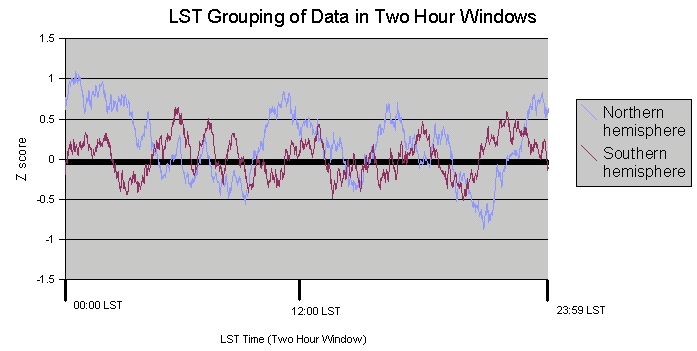|
The following graphs show the relationship of GCP data to local sidereal
time at each individual egg site. John Walker did an
early analysis,
explaining that binning by local sidereal time aggregates
data based on the apparent
position of celestial objects beyond the solar system
at each individual egg site. For example, at about 17:42 local sidereal
time the centre of the Milky Way galaxy will transit
the meridian above an egg site.
In February, 2003, Mike Meyer completed a
comprehensive look at two years of GCP data in which he concludes there
is no effect or correlation with sidereal time.
My program was set to read the raw GCP files and give each 200 bit trial
a Z score. When possible, the empirical SD was used rather than the
theoretical SD. The LST of the egg was determined, and the Z squared value was
added to the values previously stored in that sidereal minute. Each egg had its
own 1440 values stored separately, so that the results could latter be
separated into northern / southern hemispheres. For each Z squared value added,
the degrees of freedom for the egg at that minute was incremented by one.
When the two years of data had been done (Jan2000 to Dec2001), the results for
each minute could be found by adding the Z squared values of the desired
group of eggs. The same group of eggs had their degrees of freedom
added together as well. There were 36 eggs used in the northern hemisphere,
with eight in the southern hemisphere.
Once the data for the desired combination of eggs was obtained, the data was
combined into two averaging window lengths of two and four hours. The Z
score of the window was then calculated, and plotted on a graph. The data
was made to wrap around midnight, so for example the 00:00 LST point on the
two hour window graph contains data from hour zero and hour 23.
The two graphs show no signs of any effect of LST, so either there is no
effect, or the effect may be too small to be seen in this amount of data.


| 
